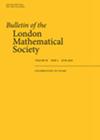A short proof of Helson's conjecture
IF 0.8
3区 数学
Q2 MATHEMATICS
引用次数: 0
Abstract
Let be the Steinhaus multiplicative function: a completely multiplicative function such that are i.i.d. random variables uniformly distributed on the complex unit circle . Helson conjectured that as , and this was solved in a strong form by Harper. We give a short proof of the conjecture using a result of Saksman and Webb on a random model for the zeta function.
Helson猜想的简短证明
设α: N→s1 $\alpha \colon \mathbb {N}\rightarrow S^1$为斯坦豪斯乘法函数:一个完全乘法函数,使得(α (p)) p ' $(\alpha (p))_{p\text{ prime}}$为i.d个均匀分布在复单位圆s1上的随机变量$S^1$。Helson推测E |∑n≥x α (n) | = 0 (x) $\mathbb {E}|\sum _{n\leqslant x}\alpha (n)|=o(\sqrt {x})$ as x→∞$x \rightarrow \infty$,这个问题被哈珀以强形式解决了。我们利用Saksman和Webb在zeta函数随机模型上的一个结果,给出了这个猜想的简短证明。
本文章由计算机程序翻译,如有差异,请以英文原文为准。
求助全文
约1分钟内获得全文
求助全文
来源期刊
CiteScore
1.90
自引率
0.00%
发文量
198
审稿时长
4-8 weeks
期刊介绍:
Published by Oxford University Press prior to January 2017: http://blms.oxfordjournals.org/

 求助内容:
求助内容: 应助结果提醒方式:
应助结果提醒方式:


